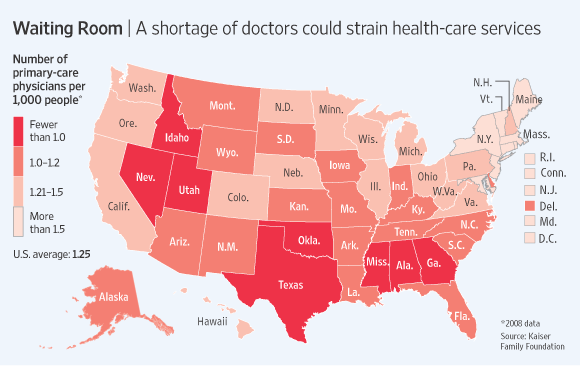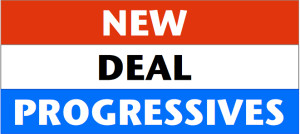The Case for a 21st Century New Deal:
Adding 4.5 Million Doctors and Nurses
Date: September 3, 2013
You may not realize it, but the U.S. currently has a doctor shortage.
Not only doctors, but nurses, dentists and eye doctors too. And it’s going to get
worse. And as with all shortages, prices for visits to the doctor’s office will increase
as well as the cost of health insurance.
Current Population & Projected Trends
The current population is about 316 million. That includes approximately 46 million
seniors; that’s projected to be about 83 million seniors in 2030.
The Census Bureau projects that the U.S. will have 438 million people by 2050
after factoring in births, deaths, and immigration.
Doctor Shortage
Currently, the U.S. has 954,000 physicians. For a current population of 316 million,
that works out to 331 patients for each doctor. But the real ratio is spread
out very unevenly.
For instance, the top 10 states with the fewest doctors are:
1. Mississippi (159.4 doctors per 100,000 people)
2. Arkansas (169.1 doctors per 100,000 people)
3. Utah (169.5 doctors per 100,000 people)
4. Idaho (172.5 doctors per 100,000 people)5. Texas (176.1 doctors per 100,000 people)
6. Alabama (178.0 doctors per 100,000 people)
7. Nevada (178.1 doctors per 100,000 people)
8. Oklahoma (178.7 doctors per 100,000 people)
9. Wyoming (178.8 doctors per 100,000 people)
10. Georgia (179.9 doctors per 100,000 people)
A list of Patients-per-Doctor ratios can be found here. In Mississippi there are
557.5 patients per doctor and in Georgia there are 480.7 patients per doctor.
And the top 10 states with the most doctors are:
1. Massachusetts (314.8 doctors per 100,000 people)
2. Maryland (281.0 doctors per 100,000 people)
3. New York (277.4 doctors per 100,000 people)
4. Connecticut (273.0 doctors per 100,000 people)
5. Maine (272.1 doctors per 100,000 people)
6. Vermont (270.7 doctors per 100,000 people)
7. Rhode Island (269.0 doctors per 100,000 people)
8. Hawaii (265.5 doctors per 100,000 people)
9. New Hampshire (257.4 doctors per 100,000 people,)
10. New Jersey (251.4 doctors per 100,000 people)
In Massachusetts there are 244.2 patients per doctor and in New Jersey there are
329.4 patients per doctor.
So based on the Patients-per-Doctor list, 40 of 50 U.S. states (including the District of Columbia) have a doctor shortage if the average is 331 patients per doctor based on total doctors and total population. Plus, there’s a real shortage of rural doctors, since most doctors are located in metropolitan areas.

Another aspect of the shortage, is the types of doctors coming into the work
force. Primary care physicians (general practitioners, internists, family physicians,
and pediatricians) face a greater shortage because more medical students
are choosing medical subspecialist fields instead of working 80-hour weeks and
earning 70%-80% less pay. Median salaries for physicians range from $146,000 to
$171,000. Earnings for subspecialists range from $325,000 to $440,000.
Many of the current physicians are around 55 years old. A third of them are nearing
retirement age, which means about 318,000 will be leaving over the next
10-15 years. This is critical because it will leave fewer practicing doctors to attend
to a growing and aging population.
And although medical school enrollment was up 3% (19,230 students) between
2010-2011,the number of medical school graduates was 17,364 in 2012, which is
fairly constant over recent years, but still not enough to make up for a mass exodus
of retiring doctors.
Nursing Shortage
There are currently 3,063,162 licensed registered nurses. Over 50% of them are
approaching retirement age in the next 10-15 years. The World Health Organization
(WHO) recommends the ideal doctor-to-nurse ratio is 1 doctor to 2.5 nurses.
Dentist Shortage
States are also struggling with Dentist shortages. As of 2009, there were 186,084
professionally active dentists in the U.S. There are over 5000 dentistry graduates each year (2.7%).
Based on a current population of 316 million, that averages out to about 1700 patients per dentist nationwide.
The top 10 states with the fewest dentists are:
1. Mississippi
2. Louisiana
3. Alabama
4. New Mexico
5. Delaware
6. South Carolina
7. Tennessee
8. Florida
9. Idaho
10. Oregon
All 50 states have dentist shortages ranging from less than 5% to 15% or greater. And more than a third of U.S. Dentists are nearing retirement age, which means that 62,028, will be leaving the workforce amid a growing and aging population.

Eye Doctor Shortage
There are about 49,000 eye doctors (31,000 optometrists and 18,000 ophthalmologists). Based on a population of 316 million, that averages out to about 6450
patients per eye doctor today.
Many eye doctors are approaching retirement age and will leave in the next
10-15 years. And as the population grows older, eye care services will be more in
demand.
What’s causing these shortages?
One reason, over the past 15 years congress and the president have both been
reducing funding for teaching hospitals via Medicare payments and redirecting
those monies to tax breaks for the wealthy and big business.
Congress also imposed a cap on funding for medical residencies, which are
needed for doctors to get licensed in order to work. Less funding means fewer
residencies for future doctors which creates shortages.
Another reason is that tuition and the amount of the student loan debt for medical
school is exorbitant and prohibitive for some. Many students may be forgoing
college because it’s beyond their means or to avoid graduating into a bad economy
with a huge debt load, ranging from $80,000 to $300,000. Student debt has
skyrocketed with high tuition and privatized student loans carrying higher interest
rates.
Last, medical schools have been slow to address these coming shortages and
typically it takes students about 10 years to get through medical school and hospital
residency to getting a license to practice medicine.
The NDP Proposal
Over the last 30 years, both Democrats and Republicans have had a direct hand
in causing these shortages by budget cuts, increasing student loan rates, privatizing
student loans, and reducing teaching hospital & residencies funding via
Medicare. All to provide tax cuts and subsidies for the wealthy and big business,
instead of the common good for the country. In effect, this has been anothermanufactured crisis self-inflicted by the president and congress for their rich
constituents.
In all four areas (physicians, nurses, dentists, and eye doctors) for the past three
decades, the U.S. has had shortages which have been growing more severe over
time. This is one reason insurance and medical costs have increased.
In addition, we need to change some of the dynamics of medical practice and
add resources accordingly.
First, the NDP believes healthcare is an individual right, so we need to fund, fill
the shortages, and stabilize the healthcare system pipeline for doctors and
nurses much like we did in the 1960s with engineers and scientists for NASA going
to the moon. Encouragement, recruitment, and tuition affordability will help
fill the gaps.
Second, we need to add free community health care clinics that require no private
insurance and can be covered by Medicare. These can be stand-alone with
professionals or using local colleges/universities to provide medical attention.
There should be an appropriately sized clinic for each 2500 residents and should
be staffed with experienced and newly licensed doctors and nurses. This will add
500,000 doctors and nurses locally.
Third, add more VA hospitals and clinics. There should be a VA hospital for every
150 mile radius; these can be big, medium, or small in size, and transportation
should be provided for veterans. There should be various sized clinics depending
in the population every 45 miles with transportation provided for veterans. This
should include home visits. This should add 100,000 doctors and nurses to the
VA.
Fourth, add home visits by doctors and nurses. These should be staffed with newly licensed doctors and nurses, who can build and continue relationships
with patients after they move to doctor offices or hospitals. These should be part of hospital residencies and include rural areas. This should add 100,000 doctors
and nurses.
Fifth, the government should assist newly licensed doctors for the first 5 years of
practice with medical liability insurance.
Last, for medical school students, until the NDP plan for free tuition is available,
reduce tuition to $7000 per year (and also offer Common Good grants in cooperation
with local, state, and federal government) and provide 1% APR low-interest
loans and offer incentives to help address national problems where doctors perform
and be clear of debt (loan forgiveness) in five years in exchange for jobs
with salary and benefits which provide experience in their chosen fields.
With these changes, we address the shortages, stop being continually shorthanded to cover the population, and stabilize healthcare for the future.
To that end, we should add 4.5 million doctors and nurses allocated accordingly:
- 300,000 physicians for public and private practice
- 1.6 million nurses
- 700,000 dentists
- 800,000 eye doctors
- 1.1 million other medical practitioners (including therapists, teachers, audiologists,
etc)
These positions can primarily be filled with American and foreign physicians seeking citizenship, but also temporarily by agreements with other countries. Adding 4.5 million doctors and nurses between 2017-2020 will address the gaps existing now. After that, adding 3.5 million doctors and nurses per decade will stabilize the health care system for a growing and aging population. These are the 2013 numbers the U.S. currently has for working doctors, nurses, dentists, and eye doctors, followed by the future numbers needed to serve the
U.S. population in the following decades:
2013 – population 316 million
Physicians: 954,000 – 331 patients per doctor
Nurses: 3.01 million
Dentists: 186,000 – 1698 patients per dentist
Eye Doctors: 49,000 – 6449 patients per eye doctor
2020 – population 339 million
Physicians: 997,000 – 340 patients per doctor
Nurses: 3.12 million
Dentists: 868,000 – 391 patients per dentist
Eye Doctors: 232,667 – 388 patients per eye doctor
2030 – population 372 million
Physicians: 1.07 million – 345 patients per doctor
Nurses: 3.5 million
Dentists: 926,000 – 402 patients per dentist
Eye Doctors: 930,000 – 400 patients per eye doctor
2040 – population 405 million
Physicians: 1.12 million – 361 patients per doctor
Nurses: 3.64 million
Dentists: 958,000 – 423 patients per dentist
Eye Doctors: 960,000 – 422 patients per eye doctor
2050 – population 438 million
Physicians: 1.15 million – 382 patients per doctor
Nurses: 3.71 million
Dentists: 977,000 – 449 patients per dentist
Eye Doctors: 978,000 – 448 patients per eye doctor
Sources:
1. “Medical Schools Can’t Keep Up”
by Suzanne Sataline and Shirley S. Wang,
Wall Street Journal online
2. “Will There Be Enough Doctors?”
by John Commins, Healthleaders Media
Council online
3. “Doctor Shortage Could Take Turn for the Worse”
by Samuel Weigley, Alexander
E.M. Hess, and Michael B. Sauter, USA Today online
4. “United States faces dentist shortage” by Roger Collier, NCBI online
5. “In Search of Dental Care”, Pew Charitable Trusts online
6. “Global Eye Doctor Shortage Growing” by Christopher Quinn, dailyRx online
7. “Census Bureau Lowers U.S. Growth Forecast, Mainly Due to Reduced Immigration
and Births”
by D’Vera Cohn, Pew Research online
8. “Physician Population Ratios and Rank by State, 2011”, Iowa Medical Society
online
9. “Nursing Shortage”, American Nurses Association online
10. “Nursing Statistics”, MinorityNurse.com online


